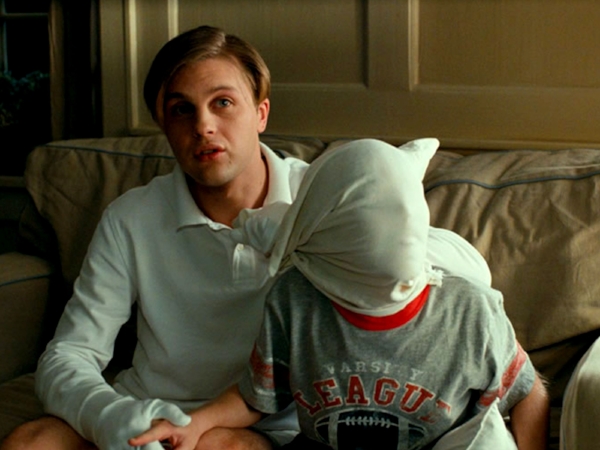'Space Chimps' on a Wild Ride Through Outer Space
Space Chimps
The New York Sun, July 18, 2008
When Alan Shepard returned safely to Earth late in the Gagarin spring of 1961, a relieved, ecstatic nation treated him to ticker tape, meet-the-president, and, subsequently, a trip to the moon. The previous astronaut sent by NASA into space hadn't fared quite so well. Emerging snarling and indignant from an edge-of-disaster suborbital shambles that was a comedy of human error and simian savoir faire, Ham had to make do with an apple, a pat on the head, and a speedy return to the desert laboratory that had, with the help of occasional electric shocks and (one hopes) more frequent banana pellets, trained him so effectively. Ham, I should say, was a chimpanzee, one of only two to escape the surly bonds of Earth — at least until Tim Burton's "Planet of the Apes."
Ham never returned to space. He was held for years in Washington, D.C.'s National Zoo before being allowed to enjoy a glorious polygamous twilight in North Carolina, a twilight that, if "Space Chimps," the latest CGI saga from Vanguard Animation ("Valiant," "Happily N'Ever After") is to be believed, left him with just one grandson, the ne'er-do-well Ham III. Voiced by "Saturday Night Live"'s Andy Samberg, he's a slacker circus chimp, clad in sub-Knievel kitsch and periodically shot from a cannon in a tawdry parody of his famous forebear's legendary feat.
Everything changes when Ham is conscripted by a flailing space agency to be the p.r. face of a mission to retrieve a probe lost on a planet at the wrong end of a wormhole. Shot into space with the "Star-Trek"-citing straight arrow Commander Titan (a Pan troglodytes Buzz Lightyear, voiced by Patrick Warburton, who played Puddy on "Seinfeld") and the coyly fetching Lieutenant Luna (Cheryl Hines), a chimpanzee hottie with more than a passing resemblance to the Zira who fell so hard for Charlton Heston's bright-eyed Taylor, Ham is forced to decide what he's going to make of himself.
In a movie not notable for its originality, it's no surprise that, in the didactic, rapscallion-with-a-heart-of-gold tradition of children's fiction, Ham ultimately discovers his better self. He helps his friends. He rescues the oppressed. He acknowledges his wise old mentor. By the end of the film, the tousled scapegrace has proved himself a worthy heir to his heroic grandfather, "a chimp," Titan says in one of the better of the entertainingly awful ape-themed puns scattered throughout this movie, "off the old block." And, yes, he ends up with considerably more than an apple.
With its chase scenes, laughable, not-too-scary villain, affable apes, lovable aliens, mild subversion of the adult world, hokey sentimentality, endemic cuteness, cheesy sound track, goofily lame jokes, gentle potty humor, and Crayola-colored extraterrestrial settings, there's probably enough in this movie to make it a good dumping ground for the kids on a rainy summer afternoon. The younger ones, at least, should have a reasonably fun time, particularly if stoned on Twizzlers and Coke. This, after all, is the demographic that enriched the Wiggles — sophistication is not the name of their game.
Despite a few, very few, amusing moments clearly designed to appeal to an older audience (on the whole I'd have preferred a few banana pellets), adults are likely to regard sitting through Ham's space odyssey as something of an ordeal. The film lacks the wit, inventiveness, and charm that made "Toy Story," say, or "Shrek" such strong intergenerational hits. That's not to deny that "Space Chimps" is, technically speaking, an accomplished achievement, certainly to anyone, such as me, brought up in the "Top Cat" era, and, I suspect, even for some of those whose early years were more Pixar than Hanna-Barbera.
But technological savvy isn't enough. This is a film that just lacks the spark necessary to keep it from what seems bound to be a lonely afterlife in the dustier corners of Blockbuster's children's section. For a film about outer space, the screenplay is miserably earthbound. Worse still, the talented cast (which also includes Jeff Daniels, Kristin Chenoweth, and Stanley Tucci) is rarely given an opportunity to do much more than simply recite lines that needed a lot more help than that.
Meanwhile, despite occasional moments of hallucinatory splendor, the almost immeasurably remote planet Malgor is routinely depicted as little more than a Pufnstuf New Mexico. Its inhabitants are, for the most part, by-the-numbers oddball creatures, with the possible exception of the creepily sweet Kilowatt (Ms. Chenoweth), a megalocephalic dollhouse Tinker Bell with, perhaps, a touch of the Murakami studio about her.
If there is one time when this movie manages to rise above itself, it's when the chimps' spacecraft first leaves Earth behind it. In a short, magical, beguiling sequence, the filmmakers manage to convey a sense of beauty, immensity, and wonder. It's a glimpse of the movie that might have been, and a hint, frustrating in its brevity, of the original Ham's strange, wild ride.









